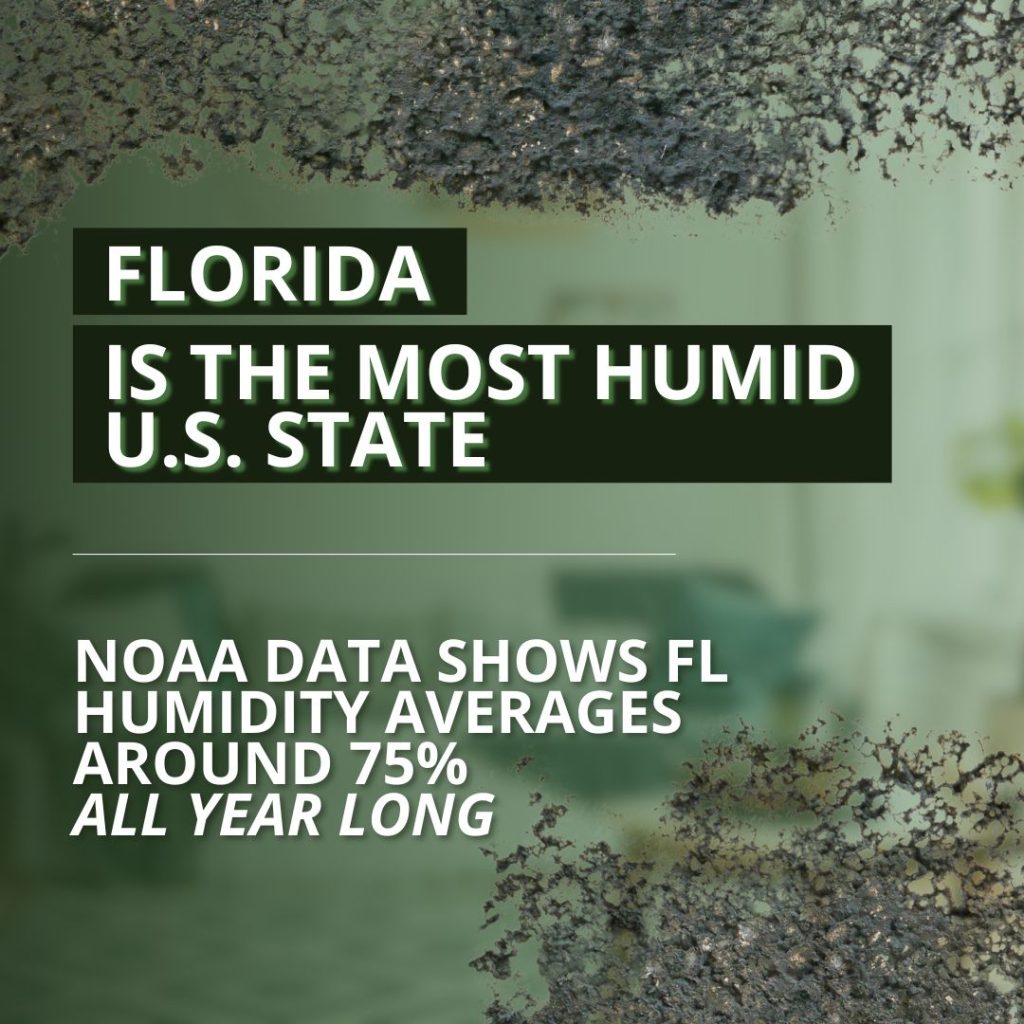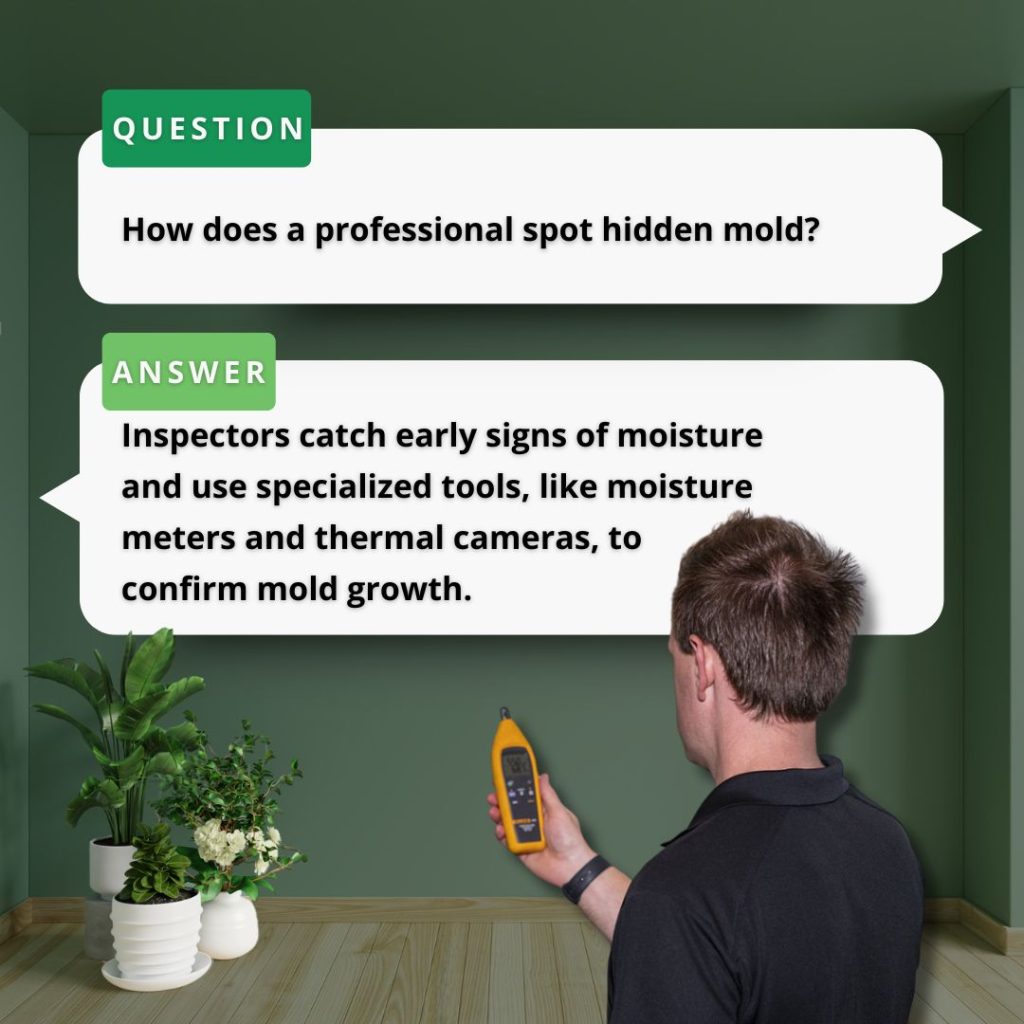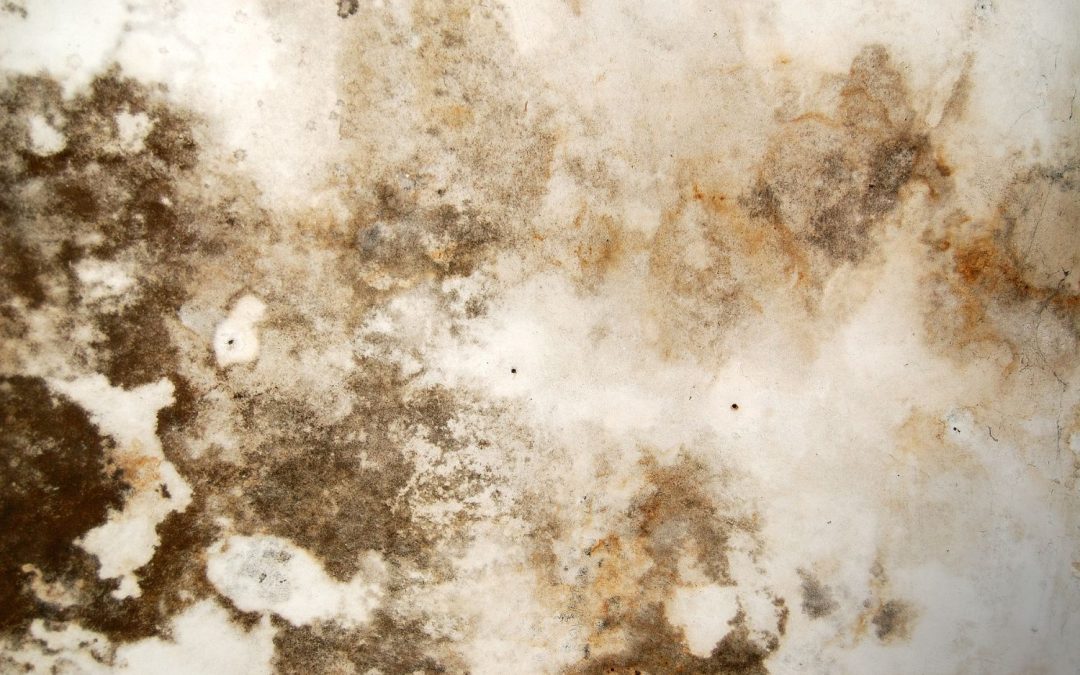Brown mold is a common type of mold found in Florida homes. It often shows up as brown or tan patches on walls, ceilings, cabinets, or HVAC surfaces. Many homeowners first notice it as small clusters of dark spots or a fuzzy brown film that slowly spreads.
Because brown mold can come from several different mold species, its appearance alone does not tell the full story.
This guide explains what brown mold is, why it forms so easily in Florida’s climate, what risks it may create, how professionals inspect, test, and verify mold conditions safely, plus how mold grows, and why proper moisture control is more important than cleaning alone.
What Brown Mold Actually Is
Brown mold refers to a range of mold species that appear in brown, tan, or dark chestnut shades. These molds thrive in warm, damp environments and often grow where moisture lingers for long periods.
The color comes from how the mold produces spores and how it reacts with the surface it grows on.
Species that commonly appear brown include:
- Aspergillus
- Cladosporium
- Ulocladium
- Aureobasidium
- Stachybotrys
Each species behaves slightly differently. Some grow in fuzzy patches, others form smooth or powdery spots. Some spread rapidly on damp drywall, while others grow more slowly on wood or fiberglass.
Even trained professionals cannot identify mold species by color or appearance alone. That is why testing is an essential part of mold investigation.
Brown mold often grows on:
- Drywall and framing
- Insulation
- Wood trim
- Bathroom tile
- Carpet backing
- HVAC components
- Cabinets and shelving
Because many types of mold can appear brown under certain conditions, homeowners should avoid assuming the species or risk level without testing.

Why Brown Mold Is Common in Florida
Florida’s environment creates near-perfect mold conditions almost every month of the year. In the Orlando area, mold problems are not limited to old homes or large leaks.
Even newer homes experience mold when humidity, water intrusion, or poor airflow create the right conditions.
1. Indoor humidity stays high for long periods
The CDC notes that mold grows easily when humidity stays above 60%. In Florida, humidity often goes much higher. Even simple daily activities like showering, cooking, or running a dryer can push indoor moisture to mold-friendly levels.
2. HVAC systems create condensation
Air conditioning helps with humidity, but long run times create cold surfaces. When warm indoor air touches cold ducts, vents, or air handler components, condensation forms.
Brown mold often grows around these areas because moisture remains long enough for spores to settle and multiply.
3. Rainstorms and water intrusion are frequent
Central Florida receives heavy rainstorms, especially in summer. Roof leaks, window leaks, and exterior drainage issues can leave moisture behind walls and under flooring. Mold continues growing long after the storm passes if the area stays damp.
4. Bathrooms and kitchens maintain moisture
Showers, baths, and cooking release moisture into the air. Without ventilation, the humidity sits on walls, tile, grout, and cabinets. Brown mold often appears in these rooms first.
5. Homes that stay closed for long periods
Short-term rentals, seasonal homes, and vacation properties often stay closed up for weeks at a time. Without airflow, humidity climbs quickly.
6. Older construction and repeated repairs
Older homes may have past leaks or materials that hold moisture longer. Newer homes may have tight building envelopes that trap humidity if ventilation is not balanced.
All of these factors explain why mold inspections and air quality testing are common requests in the Orlando area.
What Brown Mold Looks Like
Brown mold usually appears as clusters of dark brown spots, fuzzy patches, or streaks that spread outward from a moisture source. It may look dusty, soft, slimy, or leathery, depending on the species and the surface.
You may notice:
- Brown fuzzy patches on drywall
- Tan or chestnut streaks on ceilings
- Brown dust on vents or HVAC grills
- Rough, dry patches behind furniture
- Soft, darker spots on cabinets or baseboards
- Musty odors that linger even when no mold is visible
Mold color can shift depending on humidity and light. A patch that looks tan in the morning may appear darker or lighter later in the day. This is another reason visual identification is unreliable.
How Brown Mold Spreads
Brown mold spreads when moisture remains, and spores have a food source. Drywall, wood, dust, and even household fabrics can provide what mold needs to grow.
Mold spreads faster when:
- The humidity stays high
- The area stays dark or poorly ventilated
- A leak continues without repair
- HVAC systems circulate spores
- Moisture is trapped behind walls or under flooring
Mold spreads more slowly when:
- Surfaces dry out quickly
- Airflow improves
- Moisture sources are found and corrected
Even a small patch of brown mold can spread to nearby materials if humidity remains high or if water leakage continues.
Is Brown Mold Dangerous?
Brown mold can cause symptoms in some people, especially those with allergies, asthma, or sensitivities. Reactions depend on the species, the length of exposure, and the condition of the indoor environment.
Symptoms may include:
- Coughing or wheezing
- Itchy or irritated eyes
- Sneezing
- Headaches
- Worsened asthma symptoms
Some mold species, including certain strains of Stachybotrys, may produce mycotoxins. These substances can cause stronger reactions in sensitive individuals.
The CDC notes that reactions vary widely, which is why testing is used to determine what type of mold is present and whether levels are elevated. Color alone does not determine risk.
Why DIY Mold Removal Often Makes the Problem Worse
Homeowners often try to wipe or scrub visible mold, but this can spread spores into clean areas. Disturbing mold releases more spores into the air and may drive mold deeper into porous surfaces.
Cleaning mold without fixing the moisture source only offers temporary results.
Examples of common DIY mistakes include:
- Using bleach on porous materials
- Painting over mold on drywall
- Running fans toward mold-affected areas
- Scrubbing without containment
- Removing materials without sealing them first
Correct mold handling focuses on moisture control, containment, and proper removal techniques.

How Professionals Find and Confirm Brown Mold
Elite Mold Services uses several tools and methods during a mold inspection to understand the full picture.
- Moisture mapping: Moisture meters detect wet spots behind drywall, inside cabinets, or under flooring.
- Thermal imaging: Thermal cameras spot temperature changes that signal hidden leaks or moisture pockets.
- Air sampling and surface sampling: Samples are sent to an accredited lab to determine:
- Mold type
- Spore concentrations
- Whether indoor levels are elevated
- Whether growth is active
- Inspection of ventilation and HVAC systems: Inspectors check air handlers, ductwork, and condensation points to determine whether airflow or temperature differences are contributing to the mold.
- Tracing the moisture source: Mold cannot grow without moisture. Inspectors identify where that moisture is coming from so the problem can be solved properly.
This evidence-based approach helps homeowners understand what is happening and what steps they should follow.
How Professionals Handle Brown Mold
When brown mold is discovered, the path forward involves inspection, testing, and professional remediation.
Elite Mold Services focuses on the first two steps and expertly oversees remediation work to protect your home and air quality.
Improper removal can make the issue worse, so professional guidance is important. Handling usually includes:
- Containment: Plastic barriers isolate the affected area.
- HEPA filtration: Air scrubbers capture spores released during work.
- Removal of damaged materials: Porous materials like drywall or insulation may need removal if mold has grown through them.
- Cleaning and treatment: Non-porous surfaces are cleaned using specialized tools and products.
- Moisture correction: Leaks, humidity issues, or airflow problems must be fixed.
- Post-Remediation Verification (PRV): Elite Mold Services performs PRV testing to confirm that mold levels have returned to normal and that the cleanup was successful.
- This final step gives homeowners clear documentation and confidence that the area has been restored.
Other Common Questions About Mold in Central Florida
What does a full mold inspection include?
A mold inspection looks for visible growth, hidden moisture, past water damage, and conditions that allow mold to form. This also guides whether mold testing is needed.
When is mold testing recommended instead of just a visual check?
Testing is the best option when mold is suspected but not visible, when a buyer or seller needs documentation, or when post-remediation verification is required after cleanup.
What is post-remediation verification?
After a remediation contractor finishes, Elite performs a final inspection with air and surface samples to confirm the area has been cleaned correctly and is ready to reoccupy.
Can Elite help if mold keeps coming back?
Yes. Recurring mold usually means a moisture source has not been identified. Elite’s inspections locate leaks, humidity problems, or ventilation issues so repairs can be made.
When to Call a Professional
Call Elite Mold Services when:
- You see brown or tan discoloration
- You smell a musty odor
- Your home has had leaks or water damage
- You need documentation for repairs or real estate
- You want accurate mold testing and moisture evaluation
Call a remediation contractor when:
- Mold has been confirmed, and removal is needed
- Materials like drywall or insulation are damaged
- The affected area is larger than a small surface patch
Elite Mold Services can perform PRV testing after remediation to verify the results.
Conclusion
Brown mold grows easily in Central Florida due to humidity, warm temperatures, and moisture problems. Because several types of mold can look brown, testing is the only reliable way to confirm what is growing and how serious the issue is.
With proper inspection, moisture evaluation, and post-remediation verification, mold can be managed safely and prevented from returning.
Elite Mold Services provides mold inspections, testing, remediation supervision, and PRV services to help homeowners keep their indoor environment healthy and safe.

